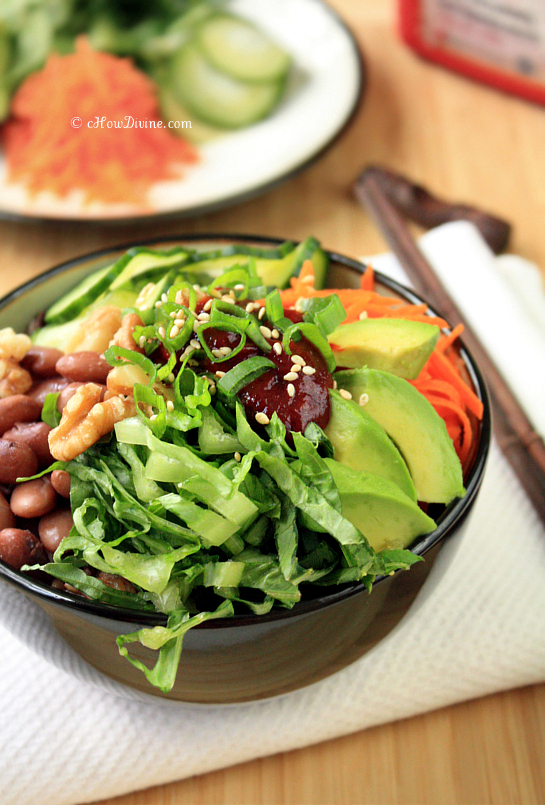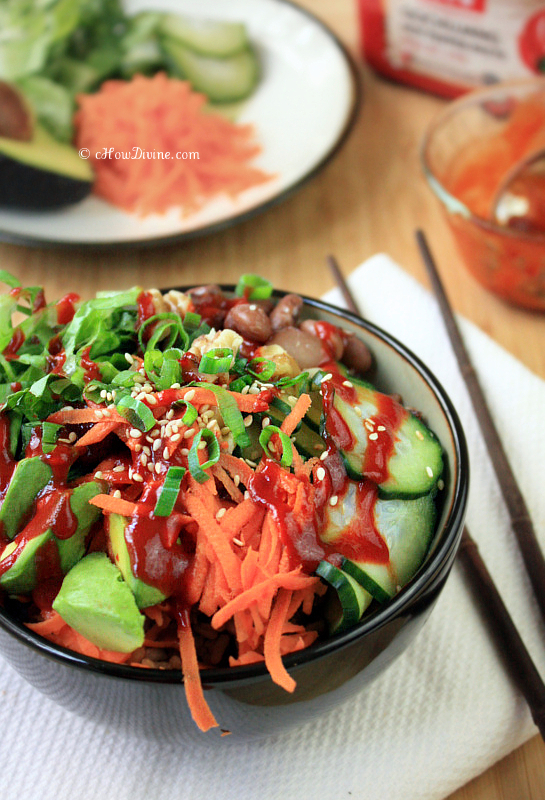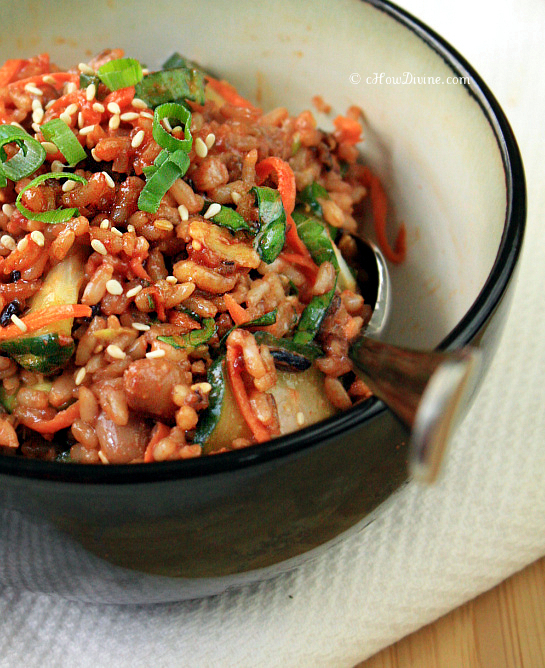Bibimbap is one of the most popular Korean dishes. Traditionally, it is made with bulgogi, fried egg, and cooked vegetables atop steamed rice. I make the traditional bibimbap from time to time, but I make this “no-cook” version when I’m so busy that I want to clone myself (which is all too often). It’s super fast and easy to make. And everyone’s satisfied at the end of the meal. It will take less than 15 minutes to put together, but it’s as satisfying to the palate as a dish that will take hours. I posted a slightly different version of this dish when I first started this blog, but I thought I would revisit it considering how often this bibimbap shows up on our dinner table.
I call this my “no-cook” bibimbap knowing full well that it is built on a foundation of cooked grains. This is because I always have hot, steamed rice in my rice cooker. So, for me, it’s “no-cook.” 😛 And if you love Asian cuisine as much as I do, you should really invest in a good rice cooker that can keep rice warm for a few days without changing the flavor. But if you are on a grain-free eating program, you can make veggie “rice” by pulsing cauliflower in a food processor until it is broken down to grain-sized pieces; then it will truly be “no-cook!”
I usually make this bibimbap with avocados (a MUST), lettuce (any variety), carrots, cucumbers, beans (for protein), and cooked grains. For this particular occasion, I used a mixture of steamed wild rice, forbidden rice, and two different types of brown rice. Of course, you can use white or sushi rice. But please use any type of grain you want: quinoa, farro, barley, etc. Use whatever you have on hand. I’m a stickler for using things you have, if you can, before you go out and purchase something new. Additionally, add walnuts and/or dried dates to the dish if you have any on hand. Although they aren’t traditionally used as toppings for Korean rice-bowl dishes, they really add to the flavor.
Lastly, I can’t write a bibimbap post without talking about gochujang (Korean red chili pepper paste). Let’s face it. It’s the gochujang that brings all the flavors together in a bibimbap. Traditionally, gochujang sauce – made in some combination of gochujang, sesame oil/seeds, sweetener, garlic, and vinegar – is used for this dish. But gochujang that are readily available in Korean markets nowadays already comes “flavored” with sweeteners and other seasonings. So, I just use the store-bought gochujang as-is. If you, however, want to make the gochujang sauce, you can use this recipe from one of my old posts. It’ll take a short amount of time to make. And it does taste better. I’m just too lazy or too busy to make it.
I probably make bibimbap with raw vegetables on a weekly basis during the warmer months. It is packed with nutrients, has amazing texture, and takes mere minutes to make. And did I mention amazingly delicious? Try it in place of your salad. It’s a salad and rice bowl in one!
Bibimbap with Raw Vegetables Recipe
Serves 2 people
Ingredients
3 cups of steamed rice
1 avocado, sliced or cubed
1 carrot, shredded
1/3 – 1/2 cup beans (pinto or black)
lettuce (romaine or red/green leaf), shredded
6 oz. (1 cup) seedless cucumbers, sliced thinly
1 TB rice vinegar
2 tsp agave nectar, honey, or sugar
gochujang*
toasted sesame seed oil
salt
Optional Toppings
walnuts, chopped
dried dates, chopped
green onions, chopped
toasted sesame seeds
- Place sliced cucumbers in a bowl. Lightly salt the cucumbers and set it aside for at least 10-15 minutes. Once the cucumbers are pliable (bend without breaking) and liquid has been drawn out, give them a quick rinse and drain well. Give them a light squeeze to further expel any water and pat them dry. Add 1 TB of rice vinegar and the agave nectar (or honey) to the cucumbers. Mix well and refrigerate until ready to use.
- Prep the other vegetables. Divide the rice and the vegetables among 2 bowls. Add gochujang to each bowl. Add a drizzle of sesame seed oil if desired. Mix well using a spoon, ensuring that the avocados are mashed and mixed into the rice. Add chopped walnuts and/or dates, if using, and mix. Top with green onions and sesame seeds if desired.
*Cook’s Note
If your tolerance to spicy foods is low, start with one tablespoon and add more if necessary. You can also DILUTE the gochujang with a little bit of water to temper the spiciness. Diluting the gochujang will allow you to use less gochujang and will also make it easier to mix. Making a gochujang sauce will also temper the spiciness. The recipe can be found here (one of my old post).
Make sure you only give the cucumbers a quick rinse. You want the cucumber pieces to retain some of the salt for flavor. Additionally, make sure to give them a squeeze to further draw out any water/liquid and pat them dry. This will allow the cucumber slices to readily sop up the vinegar and agave nectar (or honey).
Toasted sesame oil is not a must for this dish. But it will add flavor to the dish. A little bit of this oil will go a long way. Just a drizzle will do.
Trick to achieving a good, authentic tasting bibimbap is elbow grease. Really! Don’t lightly toss it or mix it. You really need to get in there and put some muscle into it.




Oh I love your “no cook” version. It comes in so handy on these hot summer days when you just don’t want to cook. Never tried avocados in bibimbap before, but it sounds interesting. I gotta try it! I LOVE avocados.
Bibimbap looks so good when I watch Korean drama and women devour it..like after they break up with a bf or come back from a bad blind date. The way they just bibyuh everything with bap and gochujang and just dig it right up while cursing the guy…so funny but it always makes me want some.
I’m gona try your no cook version for dinner. Sooo don’t feel like cooking.
Avocados are amazing in bibimbap. It goes so well with gochujang. It’s one of my go-to sauce/condiment – gochujang avocado. You must try it. My husband, who is a carnivore, is adjusting to his new eating program. And he says that this is a dish he can happily have everyday.
Bibimbap is most definitely a comfort food for me too. It makes everything a little better. Happy Saturday!
gorgeous bibimbap. you’re right entirely- the gochujang makes any combination sing. a girl on youtube (sweetandtasty) does a raw bibimbap with zucchini and carrot julienne and much of what you added. it’s charming but i find myself preferring a hot grain with my mix like yours. also i love the avocado subbing out the egg for creaminess. awesome! thanks for the recipe!
Thanks Jasi! There are many things I can live without, but gochujang isn’t one of them. I love gochujang. I put it on practically everything. I love avocados too and much prefer it over the fried egg. And yes, hot grains over the raw stuff! Let me know how it turns out if you try it. Hope you have a great weekend!
Oh Gomo, this looks absolutely mouthwatering! I think you took bibimbap to whole another level. This will be one my upcoming dinners. Thank you for sharing and have a great week ahead!
Thanks Sandra! This is one of my go-to easy dinners in the summer. It’s really satisfying and comforting. Hope you like it. Great weekend to you too!
It looks so fantastic, I am actually considering changing dinner plans… I even happen to have leftover rice, almost every day! (I was planning a very lazy meal: kimchi fried rice and a fried egg on top…). I am ashamed to say that as much as I love Korean cuisine, I have never tasted bibimbap (I have read so much about it though). Not to mention making it. I love your raw version and will certainly be making it if not tonight then in near future because I feel it might become my summer staple.
Update: I have just made it! It is extraordinary!!! I had to modify it a bit alas… I have noticed my avocado is still unripe and I didn’t have beans (substituted them with frozen peas), so finally it will be rather a light side-dish for tonight’s dinner. I had no idea it would be so soothing, cooling, perfect for a hot evening… (I hope it will keep until the dinner time though… I keep on “tasting” it straight from the fridge all the time 😉 It’s addictive!
Thank you so much for this wonderful alternative to all the leftover rice dishes I know and for another Korean discovery. I haven’t taken photos this time (too late) but you will certainly see something similar on my blog soon 😉
PS I also use agave syrup in Asian dishes all the time, so I’m relieved to see you use it in Korean cooking too. I love its neutral taste and it’s apparently quite healthy.
Yay! So glad you liked it. And thank you for letting me know how it turned out. I’m not good at making this in advance; I end up tasting it too much (until it’s gone). 🙂 But you must try it with the avocado. It takes the taste to another dimension. It is really tasty.
I love agave nectar. It really is neutral. As much as I love honey, I can’t use it for everything due to its distinctive taste. But agave, you can use it for just about anything. I do feel better about using it over sugar, but I guess it’s still sugar (fructose); so I try not to overdo it. Hope you are well!!!
I am an avocado addict; I have it practically constantly at home and eat it almost every day (in salads, open sandwiches, side dishes, maki sushi, etc.), but I was unlucky yesterday 🙁 You can be sure I will add it next time!
I knew we had a lot in common Sissi! I use avocados in place of so many things. I have a feeling you’ll notice a significant uptick in taste with the avocado! 😀
I’ve eaten many a bibimbap, but never made one. Odd, when they’re pretty easy to make. This looks terrific – I really like a veggie dish like this. Lots of gochujang sauce for me, please!
Glad to know you love gochujang too! Traditional bibimbap isn’t too difficult to make, but it is labor intensive. But this raw version is a super-lazy version of it for those humid summer days when you don’t want to cook. Let me know how it turns out if you ever make it. Hope you had a lovely weekend!
this is sooooo good, we always wanted a vegetarian version of our favorite Korean bibimbap but had not chanced until now…adorable bowl of goodies,gorgeous colors,yummm 🙂
Thank you! I prefer this veggie version to the traditional one in the summertime. I hope you give it a try. Hope you have a wonderful week!
You mention in our post that we should find a rice steamer to hold rice warm a few days. I never considered you can do that. That would be nice to have prepared on hand. I usually put it in the refrigerator but it dries out How long would it be ok? What brand steamer do you prefer. My old steamer makes crispy bottom in just a few hours
Hi Angela! Rice cookers from Cuckoo are the best. They are pricier than other brands but so worth it. Other rice cookers I’ve had in the past by Zojirushi did not cook as well and, most definitely, did not keep the flavor as well. I have an old post on making germinated rice. There are photos of Cuckoo rice cooker in the post. You can get them through Amazon. I hope this helps!
Gorgeous and something I’d truly love!
Thank you! It’s a super easy recipe. I hope you give it a try!
I have never heard of bibimbap – thank you for helping me learn something new!
It looks so colorful!
Thank you Shashi! Bibimbap is one of the most popular Korean dishes, especially outside of Korea. Let me know how it turns out if you ever try it!
Congratulations! Your dedication to providing healthy recipes to others has gotten our attention. We like your awesomeness and invite you to share your culinary creations on our new recipe index site dedicated to recipes such as these, which help to promote health and longevity. For more information please visit our site: http://www.healthyrecipeverified.com .
Congratulations to you on your new site! I look forward to visiting it.
Oh I love Bibimbap! I’ve made it a few times, but the version I make is quite labor intensive with lots of cooking of this and cooking of that. Your no-cook version has really caught my attention. Look at your ingredients, the only thing I’m missing is the lettuce. Sounds like tomorrow’s dinner to me! Thanks!
Bibimbap, although not complicated, is definitely labor-intensive. That’s why I don’t make the traditional version as often as this super-easy version. Another great thing about this bibimbap is that you can throw in whatever you have on hand. I hope you love it as much as we do. Thanks MJ! Hope you are well!
Absolutely gorgeous! I’m making this tonight!!!
Thank you Nicole! I hope you enjoy it as much as we do. Let me know how it turns out!